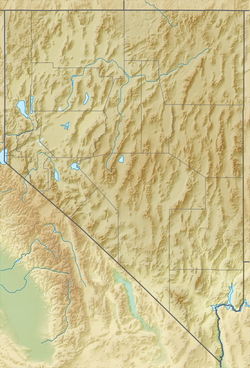Geography
The summit elevation of Mount Tenabo is 9,157 feet (2,791 m), which is 5,000 feet (1,500 m) above the surrounding valleys. Its base is covered with scrub pine. The summit and 1,500 feet (460 m) below is overgrown with grass and shrubs. Approximately 25 miles (40 km) to the north is the Humboldt River and its valley. Eastward, there are hills and valleys. To the west is the Smoky Valley, Mount Hope, Bunker Hill, and other peaks of the Toiyabe Range. [5] Mount Tenabo, east of and near the north end of the Toiyabe Range, is about 30 miles (48 km) south of Beowawe. [6]
At an area approximately 3,000 feet (910 m) above the mountain's base, a vein of silver-bearing quartz cuts through obliquely, penetrating into the valley after for 18,650 feet (5,680 m). Its width is 400 feet (120 m). This vein (stratum) contains ore beds, and is encased in crystalline limestone. [5]
This page is based on this
Wikipedia article Text is available under the
CC BY-SA 4.0 license; additional terms may apply.
Images, videos and audio are available under their respective licenses.
